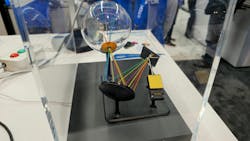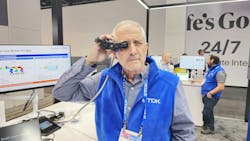Projecting Images into the Eye of the Beholder
What you’ll learn:
- How mini-lasers can project images into the eye.
- How laser projection can be used in augmented and virtual reality.
Most augmented- and virtual-reality (AR/VR) systems present an image on a plane in front of the eye. TDK was showing off an alternate approach that projects images directly into the eye instead of having a person view the reflection of an image (Fig. 1).
For AR, the advantage is that the display doesn’t have to compete with the rest of the optics. That’s because the display must also allow passthrough of the image from the outside world.
The implementation is still in the lab and not something that’s a product yet (Fig. 2). A number of challenges remain, from safety issues to repeatability, but these are being addressed by TDK. There are many advantages over the conventional reflected imaging approach, such as image correction and customization for individual users.
Positioning the laser module is easy for VR applications—only the projector needs to be in front of the eye. AR is more of a challenge, as positioning should not block the normal eye view of the outside world. Of course, challenging optics are already part of any AR solution; reflecting the laser beam from a side-mounted projection system is already being done.
One might think from this discussion that both AR approaches are the same. However, the difference lies in where the image is in focus. The conventional approach puts it on the display plane, while TDK’s eye projection system puts it in the eyeball. This is easy to see—a camera view of the conventional system will see the projected image while the new approach will not.
Will this technology ever make it into products? We’ll have to stand by on that front, but its advantages are worth the wait.
>>Check out more of our CES 2025 coverage
About the Author
William G. Wong
Senior Content Director - Electronic Design and Microwaves & RF
I am Editor of Electronic Design focusing on embedded, software, and systems. As Senior Content Director, I also manage Microwaves & RF and I work with a great team of editors to provide engineers, programmers, developers and technical managers with interesting and useful articles and videos on a regular basis. Check out our free newsletters to see the latest content.
You can send press releases for new products for possible coverage on the website. I am also interested in receiving contributed articles for publishing on our website. Use our template and send to me along with a signed release form.
Check out my blog, AltEmbedded on Electronic Design, as well as his latest articles on this site that are listed below.
You can visit my social media via these links:
- AltEmbedded on Electronic Design
- Bill Wong on Facebook
- @AltEmbedded on Twitter
- Bill Wong on LinkedIn
I earned a Bachelor of Electrical Engineering at the Georgia Institute of Technology and a Masters in Computer Science from Rutgers University. I still do a bit of programming using everything from C and C++ to Rust and Ada/SPARK. I do a bit of PHP programming for Drupal websites. I have posted a few Drupal modules.
I still get a hand on software and electronic hardware. Some of this can be found on our Kit Close-Up video series. You can also see me on many of our TechXchange Talk videos. I am interested in a range of projects from robotics to artificial intelligence.



